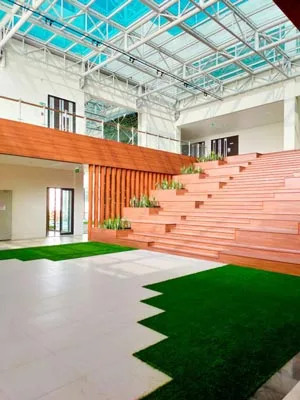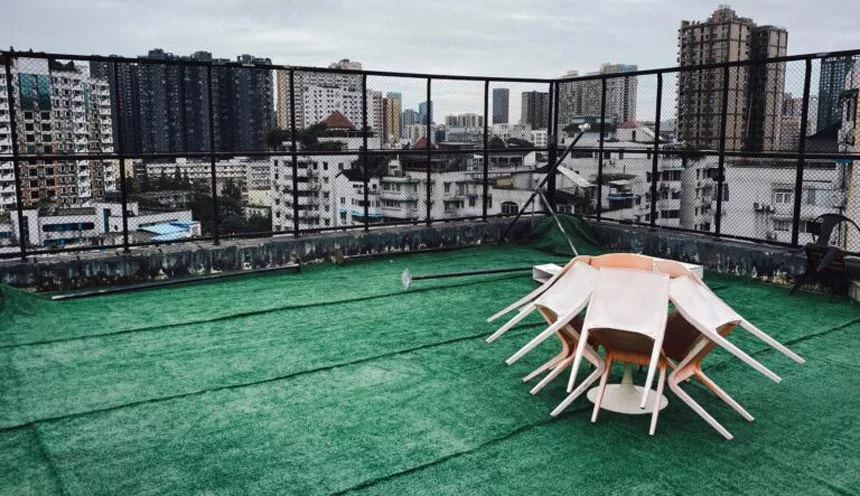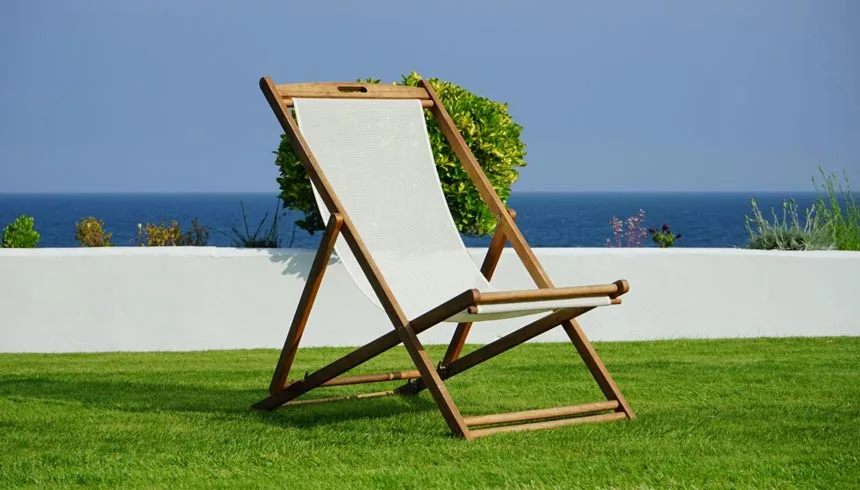This DIY guide will help you install a lush-looking lawn by going through each step of the process with you. Don’t worry if you’ve never installed a sprinkler system before, you’ll be guided through each step so you get a great-looking lawn at the end of it.
Installing artificial grass may seem daunting, but with these easy steps, you can do it yourself and have a lush, green lawn in no time!
How Much Does Professional Turf Installation Cost?
Artificial grass has been around for many years, but it has only been in the last decade that it has become popular for home use. There are many reasons for its popularity. One of the main reasons is that it is low maintenance. You do not have to worry about mowing the lawn or watering it. Another reason is that it is safe for children and pets. It is also environmentally friendly.
If you are thinking about installing artificial grass in your home, you will first need to determine how much it will cost. The cost of installation will depend on the size of your lawn, the type of grass you choose, and the company you hire to install it.
You can install artificial grass yourself, but it will be a lot easier if you hire a professional. The cost of hiring a professional will vary depending on the company you hire, but it will typically cost between $600 and $1,200.
Should I Hire a Professional?

There are many reasons why you might choose to install artificial grass yourself. Perhaps you want to save money, or you’re confident in your DIY skills. However, there are several good reasons why you might want to hire a professional.
Artificial grass installation is a complex process that requires special tools and knowledge. If you’re not familiar with the process, you could easily make mistakes that could damage your lawn or decrease its life expectancy.
A professional installer will have the experience and knowledge to do the job right the first time. They’ll also have the necessary tools and equipment, which can be expensive to purchase yourself.
If you’re unsure about whether or not to hire a professional, ask them for references or read online reviews. By doing your research, you can make an informed decision about what’s best for you and your lawn.
Measure the Size of Your Yard
To measure the size of your yard, you will need to use a tape measure. Start by measuring the length and width of your yard. Once you have the measurements, you will need to convert them to square yards. To do this, simply multiply the length by the width. This will give you the total square yards of your yard.
Determine How Much Artificial Grass You Will Need
Now that you know the size of your yard, you can determine how much artificial grass you will need to purchase. If your yard is smaller than 10 square yards, you will need to purchase 10 square yards of artificial grass. If your yard is larger than 50 square yards, you will need to purchase 50 square yards of artificial grass.
Difficult Soil
If you are looking to install artificial grass in an area with difficult soil, it is important to first introduce some difficult soil amendments to improve the quality of the soil. By doing so, you will help to create a foundation that the artificial grass can root into and create a more lush and natural appearance. Some common difficult soil amendments include compost, peat moss, and sand.
Mix the difficult soil amendments into the soil
Once you have selected the appropriate difficult soil amendments, mix them into the soil evenly. Be sure to mix them in deep enough so that they will reach the root zone of the artificial grass.
Given Time
Installing artificial grass is a big project, and it’s important to allow enough time to complete it properly. You’ll need to factor in the time it takes to measure and layout the turf, as well as the time needed to cut and attach it to the ground. You’ll also need to allow for the adhesive to dry completely before using the area.
How to install artificial grass yourself

Understanding the steps in the artificial turf installation process is essential if you want your artificial turf project completed on time and on budget.
In 6 simple steps, you can install an artificial turf yourself.
Step 1: Tools and Materials
Installing artificial grass yourself can save you a lot of money, but it’s important to have the right tools and materials. Here’s a list of what you’ll need:
Tape measure
Tape measurement is an important tool for installing artificial grass. It can help you measure the length and width of the area you plan to install the artificial grass.
Utility knife
When installing artificial grass, a utility knife is a must-have tool. The blade is perfect for cutting through the turf, and the retractable feature ensures that you won’t have to worry about injuring yourself.
Stapler
A Stapler is a hand tool that inserts staples into paper or other materials to fasten them together.
Plywood
you’ll need to purchase some plywood. The amount you’ll need will depend on the size of your yard or garden, but you should plan on buying at least one sheet. Make sure to choose quality plywood that is designed for outdoor use, as it will be more resistant to moisture and weathering.
Screws
Screws are an important part of installing artificial grass. They help secure the turf to the ground and keep it in place. When selecting screws for your project, make sure to choose a type that is compatible with the surface you are installing the turf. For example, if you are installing artificial turf on a wooden deck, you will need screws that are designed to penetrate the wood.
Hacksaw
A hacksaw is an important tool for artificial grass installation. It is used to cut the artificial turf to the desired size and shape.
Lawn roller
A lawn roller is an important tool for artificial grass installation. It can help to compact the artificial grass and make it more stable. In addition, the lawn roller can also help to remove the wrinkles on the artificial grass, making it look more natural.
Artificial grass
Artificial grass, also known as synthetic turf, is a man-made surface made to look and feel like natural grass. It is most often used in arenas for sports that are traditionally played on grass, such as football, soccer, and rugby. However, it can also be used for other purposes, such as in gardens, on playgrounds, and as roofing.
The benefits of artificial grass are many. It is a low-maintenance surface, meaning that it does not require regular mowing, watering, or fertilizing. It is also a durable surface, meaning that it can withstand a great deal of wear and tear. Additionally, it is an environmentally-friendly surface, as it does not require the use of pesticides or herbicides and it can be recycled.
Artificial grass is becoming increasingly popular, as more and more people are discovering its many benefits. If you are interested in installing artificial grass yourself, there are a few things you need to know.
Choose the right type of artificial grass
There are many different types of artificial grass available on the market. When choosing the right type of grass for your needs, you need to consider the climate, the amount of use the surface will get, and your budget.
If you live in a warm climate, you will need a type of grass that can withstand high temperatures. If you live in a cold climate, you will need a type of grass that can withstand cold temperatures. If the surface will be used heavily, you will need a type of grass that is durable. And if you have a limited budget, you will need to consider the cost of the grass.
Seam tape
Seam tape is available at most home improvement stores. It is important to read the instructions carefully before using it, as the incorrect application can lead to problems with the artificial grass. Seam tape should be applied in a continuous strip along the entire seam, and it should be evenly applied to both the top and bottom of the seam. Once the tape is in place, the artificial grass can be installed.
Glue
Artificial grass needs to be glued to a hard surface to keep it in place. The best way to do this is by using a construction adhesive. You can find this at any hardware store.
Spray adhesive
When installing artificial grass, spray adhesive is an essential tool. It helps the grass stay in place and prevents it from moving around. It is also important for securing the seams between pieces of grass.
Mulch
Mulch is an important part of artificial grass installation. It helps to protect the grass and keep the ground moist. It is also important to keep the area free of debris and weeds.
Tools and materials are important for any project, but they’re especially important when installing artificial grass yourself. Make sure you have everything you need before you start, so you don’t have to stop in the middle of the project.
Step 2: Excavation
Before installing artificial grass, it is important to excavate the area to be covered. This involves removing all of the existing vegetation and soil down to the desired depth. The area should be leveled off and any large rocks or other obstacles removed.
Step 3: Build Base
If you’re looking to install artificial grass yourself, you’ll need to start by building a base. This is because artificial grass needs to be installed on a level surface in order to look and feel its best. A base can be made out of a variety of materials, but the most common is a layer of compacted gravel.
Step 4: Measure, Cut, and Lay Grass
Measure the area you will be installing the grass
- Lay the grass out in the area to get an idea of the layout and how much you will need
- Determine the area that you will need to start laying the grass from
- Begin to lay the grass by unrolling it and pressing it into the ground
- Stick the grass together as you go by using a spray bottle filled with water and spraying the adhesive onto the back of the turf
- Trim the edges of the grass with a sharp blade
- Use a hose to clean the artificial turf and remove any debris
Cut the grass to size
Installing artificial grass yourself can be a daunting task, but it can be done with a little bit of know-how. One of the most important things to keep in mind when installing artificial turf is to ensure that the blades are cut to the correct size. Blades that are too long will not look natural, and they may also create a tripping hazard. Conversely, blades that are too short will not look realistic and may also be prone to matting. When cutting artificial turf, use sharp scissors or a utility knife and be sure to cut in the direction of the nap.
Step 5: Secure the Perimeter
Installing artificial grass yourself can be a fun and rewarding experience, but it is important to secure the perimeter of the installation area to prevent accidents and injuries. Make sure to use stakes and ropes to keep people and pets from entering the area while the grass is being installed.
Step 6: Infill and Finishing Touches
The installation of artificial grass is a big investment for your home or business. It is important to take the time to do the job right so that you can enjoy your artificial grass for years to come. The most important part of the installation is the infill. The infill is what holds the blades of grass up and gives the grass its realistic look. The type of infill you choose will depend on the climate you live in and the amount of use your artificial grass will get.
There are three main types of infill: sand, rubber, and crushed recycled glass. Sand is the most common type of infill and is best for climates that are hot and dry. Rubber is a good choice for climates that are cold or wet. Crushed recycled glass is a good choice for high-traffic areas.
Once you have chosen the type of infill, you need to spread it evenly over the surface of the artificial grass. Use a broom to spread the infill evenly and then use a roller to press it into the surface of the grass.
The final step in the installation process is to add the finishing touches. Trim the edges of the artificial grass and use a glue gun to attach the edges to the surface of the ground. Make sure the edges are securely attached so that they do not come loose over time.
Is it the right decision to install artificial grass?

Artificial grass is a great option for a variety of reasons: it’s low-maintenance, durable, and looks great. However, before you make the decision to install artificial grass yourself, it’s important to consider the following factors:
- The climate in your area
- The size of your yard
- The type of artificial grass you want to install
Once you’ve considered these factors, you can then decide if installing artificial grass yourself is the right option for you.
Most Popular FAQ: how to install artificial grass yourself
Do you have to put sand on top of artificial grass?
No, you do not have to put sand on top of artificial grass.
Can you lay artificial grass yourself?
Yes, you can lay artificial grass yourself. However, it is a big job and it will take some time and effort to do it properly.
How do I prepare the ground for artificial grass?
The ground must be flat and as smooth as possible before installing artificial grass. Remove any rocks, sticks, or other debris from the surface. Use a rake to level the ground and pack down any bumps or lumps. If the ground is wet, allow it to dry completely before installing the artificial grass.
How do you lay artificial grass for beginners?
Artificial grass can be a great addition to your home or garden, but it can be tricky to install yourself. Here is a guide on how to install artificial grass for beginners:
1. Measure the area you would like to install the artificial grass.
2. Purchase artificial grass.
3. Remove any existing vegetation or debris from the installation area.
4. Level the area and add a layer of crushed stone.
5. Cut the artificial grass to size and attach it to the ground using stakes or adhesive.
6. Trim any excess artificial grass.
7. Enjoy your new artificial grass!
What should you put under artificial grass?
There are a few things you should put under artificial grass to make sure it stays in place and looks nice. You should put down a weed blocker, like landscape fabric, to keep weeds from growing up through the artificial grass. You should also put down a layer of sand or gravel to help keep the grass in place and to make it look nicer.
Can you lay artificial grass straight onto soil?
No. It is best to lay a synthetic grass mat onto a flat, hard surface such as concrete or wood.
How hard is it to put artificial grass?
Installing artificial grass is a relatively easy process, but it can be time-consuming. You will need to measure the area where you plan to install the grass, mark the boundaries, and then cut the grass to size. Once the grass is cut to size, you will need to spread the adhesive and then install the grass. Make sure that you follow the instructions carefully to ensure that the grass is installed correctly.
Do I need a membrane under artificial grass?
No, you generally do not need a membrane under artificial grass, but it is recommended in high-traffic areas.
Can dogs pee and poop on artificial grass?
Yes, dogs can pee and poop on artificial grass without any issues. Artificial grass is a great option for pet owners because it is easy to clean and maintain.
Does artificial grass need to be glued?
No, artificial grass does not need to be glued.
What do you put under artificial grass?
The base you put under artificial grass is very important, as it will affect the longevity and look of your artificial grass. You will want to use a material that is durable and can support the weight of the artificial grass. Common materials used for artificial grass bases include gravel, sand, or crushed stone.
Can I lay artificial grass myself?
Yes, you can install artificial grass yourself, but it is a challenging and time-consuming project. You will need to prepare the surface well and use a strong adhesive to ensure a good bond.
Do you need drainage under artificial grass?
Yes, most types of artificial grass need some form of drainage in order to function properly and look their best. If you are installing the grass yourself, you will need to create a drainage system underneath it. This can be done by digging a trench and installing a drainage pipe, or by using a drainage mat.
What do you put under artificial turf before laying?
You put down a weed-block fabric to prevent weeds from growing up through the turf.
Can you lay artificial grass on uneven ground?
Yes – you can install artificial grass on uneven ground, but you will need to take some extra steps to ensure a level surface. You can either use a self-leveling compound or a layer of sand or gravel to even out the surface.
How do you secure artificial grass edges?
There are a few ways to secure the edges of artificial grass. One way is to use landscape fabric or burlap to secure it to the ground. You can also use a metal or plastic edging to keep the grass in place.
Can artificial grass be laid on dirt?
Yes, artificial grass can be laid on dirt, although it is not recommended. If the dirt is not compacted and has a lot of organic material, it can cause the artificial grass to buckle over time.
Conclusion
Artificial grass has many advantages, the main one being its low maintenance. You do not have to worry about cutting or watering it. It is also safe and environmentally friendly for children and pets. It will make your life more colorful.



